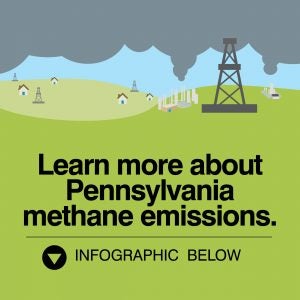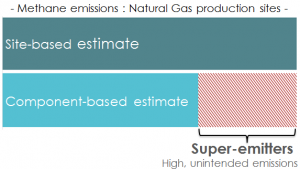 Pennsylvania is the nation’s second largest producer of natural gas, yet the state’s gas industry is guilty of leaking massive quantities of methane – essentially the gas itself – into the atmosphere. Fortunately, the state’s Department of Environmental Protection is taking steps to ensure Pennsylvania is leading on energy, not on air pollution. Here are five reasons why state leaders are moving forward to address invisible, yet harmful, methane emissions. Read More
Pennsylvania is the nation’s second largest producer of natural gas, yet the state’s gas industry is guilty of leaking massive quantities of methane – essentially the gas itself – into the atmosphere. Fortunately, the state’s Department of Environmental Protection is taking steps to ensure Pennsylvania is leading on energy, not on air pollution. Here are five reasons why state leaders are moving forward to address invisible, yet harmful, methane emissions. Read More
Energy Exchange
Five Reasons Pennsylvania is Taking Action on Methane
Five Far Reaching Opportunities to Modernize California Natural Gas Policy
 As he settles into his final two years as California’s longest-serving Governor, Jerry Brown has limited time to finalize his energy and climate policy legacy. Meanwhile, with a new crop of state legislators and two new appointees at the California Public Utilities Commission (CPUC), California has a fresh set of actors who will be actively questioning the way things are — and the way things should be.
As he settles into his final two years as California’s longest-serving Governor, Jerry Brown has limited time to finalize his energy and climate policy legacy. Meanwhile, with a new crop of state legislators and two new appointees at the California Public Utilities Commission (CPUC), California has a fresh set of actors who will be actively questioning the way things are — and the way things should be.
While there are a lot of economic sectors that will be under the microscope for the next two years, for natural gas policy, these five key opportunities will likely have the most relevance. Read More
Aliso Canyon Decisions Must Be About More Than Just Near-Term Safety
 After months of speculation, the California agency in charge of setting standards for oil and gas operations (“DOGGR”) this week announced a pair of meetings to take public comment on the reopening of the Aliso Canyon Natural Gas Storage Facility.
After months of speculation, the California agency in charge of setting standards for oil and gas operations (“DOGGR”) this week announced a pair of meetings to take public comment on the reopening of the Aliso Canyon Natural Gas Storage Facility.
This development stems from legislation passed in 2016 (SB 380), and is expected to be among the final steps before Southern California Gas Corporation (SoCalGas) is allowed to restart limited use of the facility. So, while it’s critical for the state to get its decisions right for safety and near-term electric reliability related to Aliso, to fully comply with SB 380, the decisions being made also need to take into account the larger issues facing California today. Read More
Super-emitters Are Real: Here Are Three Things We Know
As part of our landmark 16-study series and ongoing work in measuring methane emissions, we previously published a paper that compared and reconciled top-down (airborne-based measurements ) with bottom-up (emissions inventory, using ground-based measurements) emissions.
This paper found that 1% of natural gas production sites accounted for 44% of total emissions from all sites, or 10% of sites 80% of emissions; emission estimates were based on facility-wide (site-based) measurements. Sites or equipment that produce disproportionate shares of total emissions are often called “super-emitters”. A big question that remained was what caused some sites to become a super-emitter; this remained a “black box” without additional knowledge about which components or operational conditions within a site could trigger the high-emissions.
New Study Improves Understanding of Natural Gas Vehicle Methane Emissions, But Supply Chain Emissions Loom Large
 By Joe Rudek and Jason Mathers
By Joe Rudek and Jason Mathers
Many commercial fleet operators have considered switching their fleet vehicles from diesel to natural gas to take advantage of the growing abundance of natural gas and reduced emissions. Natural gas trucks have the potential to reduce nitrogen oxides emissions (NOx) from freight trucks and buses.
Yet, adopting the emission reduction technologies and practices needed to curb the methane escaping during the production, transport and delivery of natural gas is critical to unlock the full environmental potential of these vehicles. Methane, the main component of natural gas, is a potent greenhouse gas released to the atmosphere at every step from production wells to the vehicle fuel tanks. Even small amounts of methane emitted across the natural gas supply chain can undermine the climate benefit of fuel-switching vehicles to natural gas for some period of time, as EDF research has shown. Read More
EDF Methane Mapping Partnerships Accelerate Technological Advances in Gas Utility Sector
 The New York Public Service Commission recently approved plans by National Grid, the largest distributor of natural gas in the Northeast, to use advanced leak detection and quantification technologies developed by EDF and Google Earth Outreach in order to maximize the environmental and ratepayer benefits of a three-year, $3 billion capital investment program. This program includes plans to replace 585 miles of old, leak-prone pipes on the company’s systems in Long Island and parts of New York City.
The New York Public Service Commission recently approved plans by National Grid, the largest distributor of natural gas in the Northeast, to use advanced leak detection and quantification technologies developed by EDF and Google Earth Outreach in order to maximize the environmental and ratepayer benefits of a three-year, $3 billion capital investment program. This program includes plans to replace 585 miles of old, leak-prone pipes on the company’s systems in Long Island and parts of New York City.
The Commission’s December 16 order marks a major step forward in EDF’s efforts to accelerate the diffusion of environmentally beneficial technologies – in this case cutting edge methane emission measurement tools – by natural gas utilities. Read More










